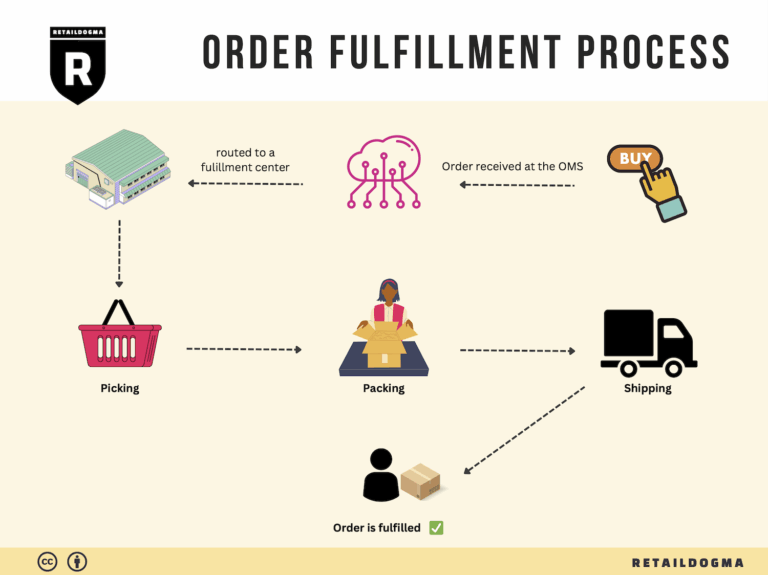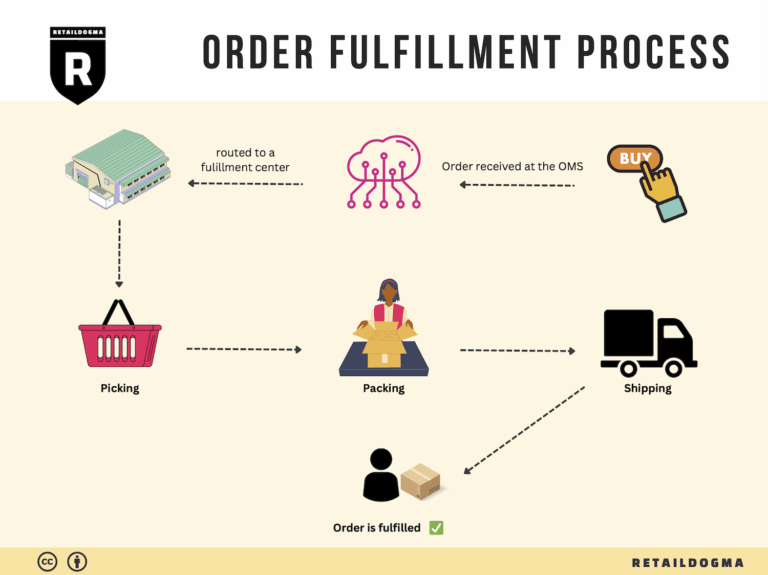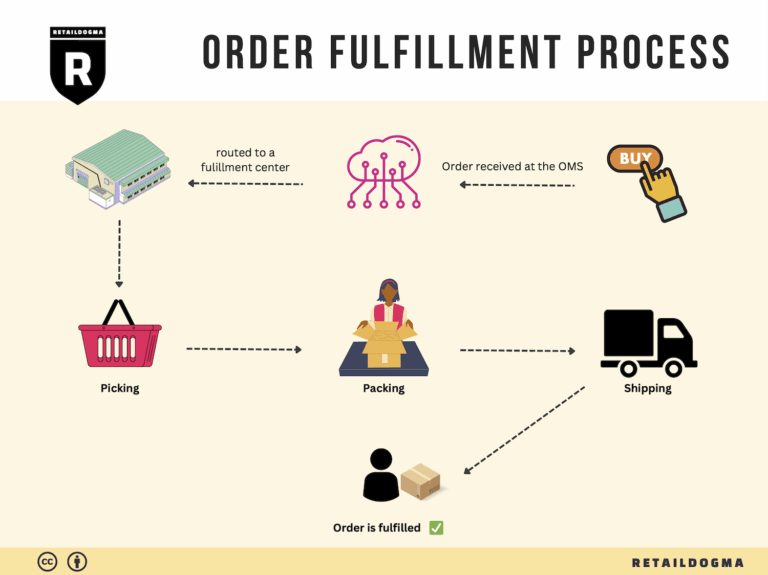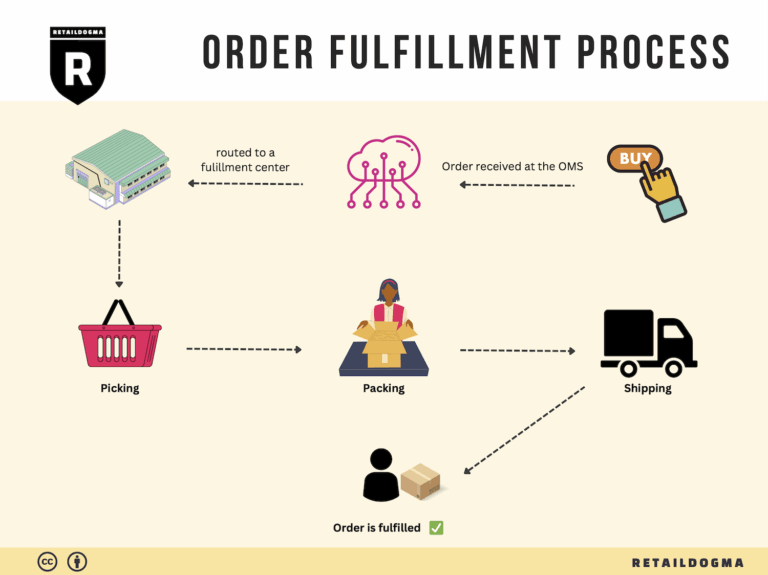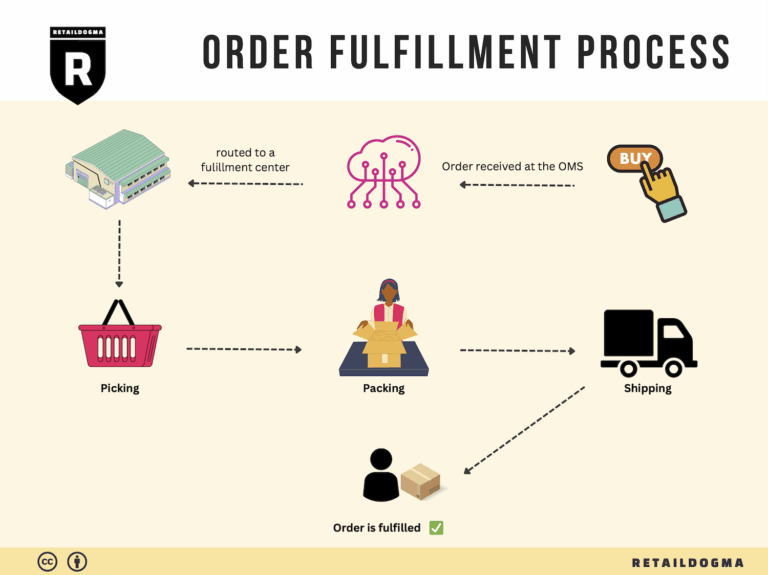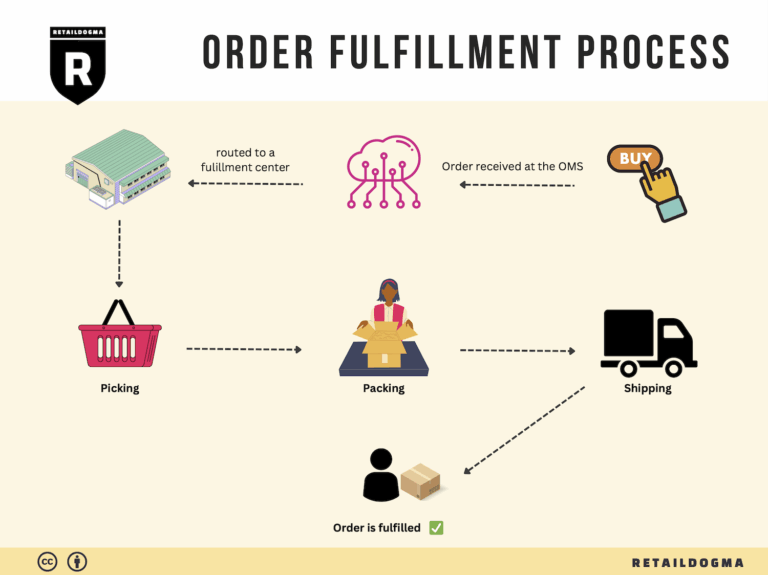Ecommerce Fulfillment Services: The Ultimate Guide (2025)
What is E-commerce Fulfillment? An Introduction for Growing Businesses
Understanding the Challenges of Order Fulfillment
As your e-commerce business begins to grow, the excitement of increased sales can quickly turn into a daunting challenge. One of the most common pain points for online retailers is the overwhelming task of packing and shipping orders. What starts as a manageable operation can quickly spiral into chaos, leading to delays, mistakes, and dissatisfied customers. The fulfillment process—the critical journey of getting a product from your inventory to your customer’s doorstep—can become a significant bottleneck if not handled efficiently.
Defining E-commerce Fulfillment
E-commerce fulfillment is the comprehensive process that encompasses everything from receiving inventory and storing it, to picking, packing, and shipping orders directly to customers. It also includes managing returns and ensuring that customer expectations are met throughout the buying journey. For growing businesses, understanding and mastering fulfillment is crucial not just for operational efficiency, but also for maintaining customer satisfaction and loyalty.
What This Guide Covers
In this guide, we will explore various fulfillment models, including Third-Party Logistics (3PL) and Fulfillment by Amazon (FBA), and how they can impact your business operations. We will delve into the core services offered by these models, such as inventory management, order processing, and returns handling, helping you understand what to look for in a fulfillment partner.
Additionally, we will provide practical insights on how to choose the right logistics partner for your specific needs, focusing on factors like scalability, technology integration, and customer service. Pricing is another critical aspect we will address, as understanding the cost implications of different fulfillment options can help you make informed decisions that align with your budget and growth goals.
Empowering Your Logistics Decisions
The ultimate goal of this guide is to empower you, the e-commerce business owner, operations manager, or entrepreneur, to make smart and strategic decisions about your logistics and fulfillment processes. By demystifying e-commerce fulfillment and providing actionable insights, we aim to equip you with the knowledge you need to streamline your operations, enhance customer satisfaction, and scale your business efficiently.
What You’ll Learn In This Guide
- What is E-commerce Fulfillment? An Introduction for Growing Businesses
- The Order Fulfillment Process: From ‘Buy’ Button to Customer’s Door
- Comparing Fulfillment Models: In-House vs. 3PL vs. Dropshipping
- A Deep Dive into Amazon FBA: Pros, Cons, and Who It’s For
- Core Services Offered by Fulfillment Centers
- How to Choose a Fulfillment Partner: A 6-Point Checklist
- Understanding Fulfillment Pricing: A Breakdown of Common Fees
- Frequently Asked Questions (FAQs) about Fulfillment
- Conclusion: Is Outsourcing Fulfillment the Right Move for Your Business?
- Important Disclaimer
The Order Fulfillment Process: From ‘Buy’ Button to Customer’s Door
1. Receiving Inventory
The first step in the order fulfillment process is receiving inventory. When products arrive at the fulfillment center, they must be checked against purchase orders to ensure accuracy. This involves verifying quantities, inspecting for damage, and confirming that the right items have been delivered. Each product is assigned a unique Stock Keeping Unit (SKU), which is crucial for tracking and managing inventory efficiently.
Importance: Properly receiving inventory is vital for maintaining accurate stock levels, which directly impacts order fulfillment efficiency and customer satisfaction. Any discrepancies can lead to stockouts or overstock situations, complicating future order processing.
Key Term: SKU (Stock Keeping Unit) – A unique identifier for each distinct product and service that can be purchased.
2. Warehouse Storage
Once the inventory has been received and verified, it is organized and stored in the fulfillment center. This process often employs strategic layout techniques to optimize space and streamline picking operations. Products are categorized and placed in designated areas, which can be based on size, type, or sales velocity. Implementing an efficient Warehouse Management System (WMS) helps manage these locations and track stock levels in real-time.
Importance: Efficient storage solutions minimize the time needed to locate and pick items for orders. A well-organized warehouse not only speeds up the fulfillment process but also helps reduce operational costs associated with misplaced or lost items.
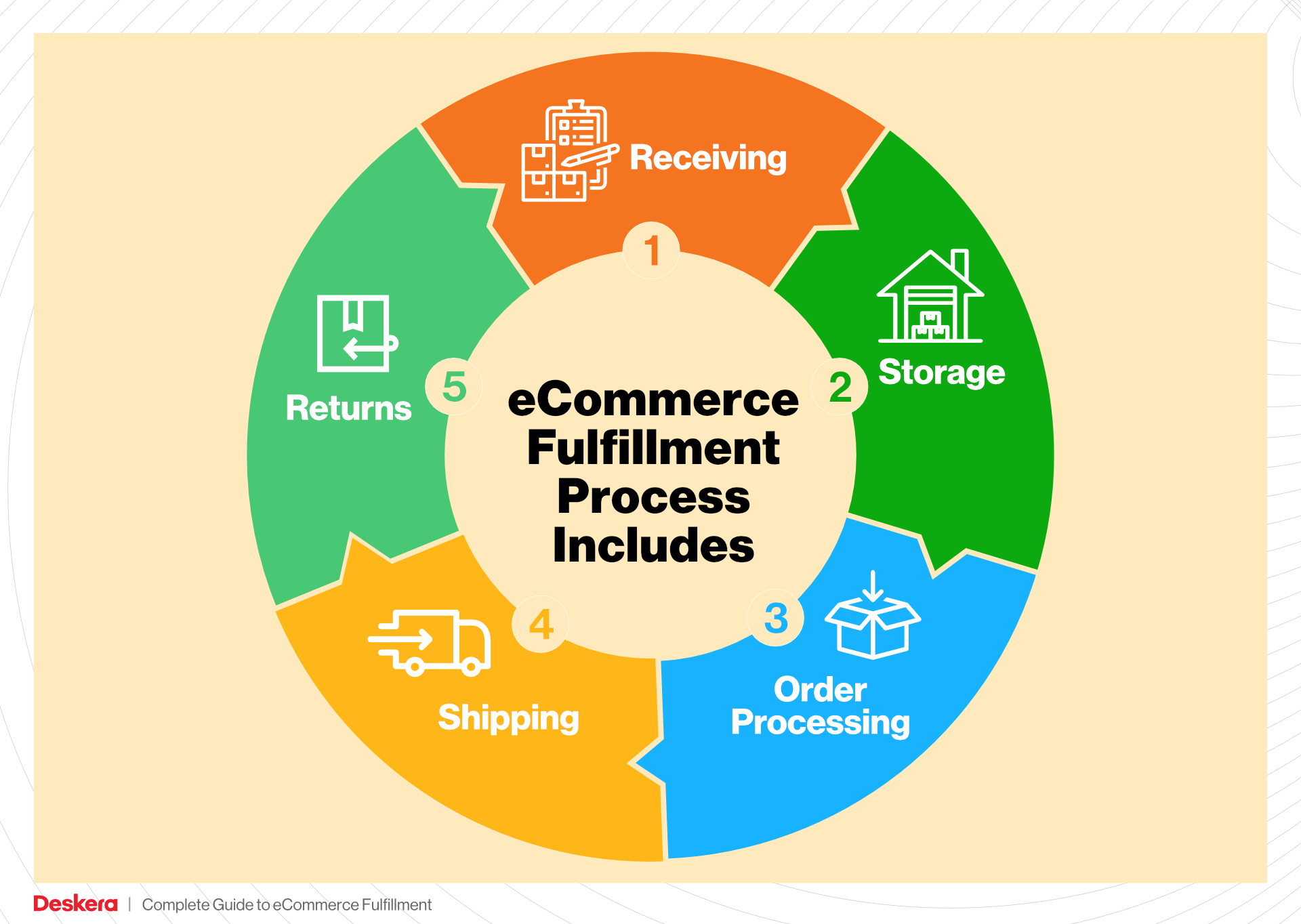
Key Term: Warehouse Management System (WMS) – A software application designed to support warehouse or distribution center management, facilitating efficient inventory tracking and storage.
3. Order Picking
Order picking is the process of selecting items from their storage locations to fulfill customer orders. This step can be executed through various methods, including single order picking, batch picking, or wave picking. The chosen method typically depends on the volume of orders and the layout of the warehouse. A pick list is generated, which outlines the items and quantities needed for each order.
Importance: Accurate and efficient picking is crucial for ensuring that customers receive the correct products in a timely manner. Errors during this stage can lead to returns, refunds, and diminished customer trust, all of which can negatively affect your bottom line.
Key Term: Pick List – A document or digital report that details the items to be collected from the warehouse to fulfill a customer order.
4. Order Packing
After items are picked, they are brought to the packing area where they are prepared for shipment. Packing involves placing products into appropriate shipping containers, ensuring that they are protected from damage during transit. This step also includes labeling packages and, in many cases, including packing slips or promotional materials. Custom packaging can enhance branding and improve customer experience.
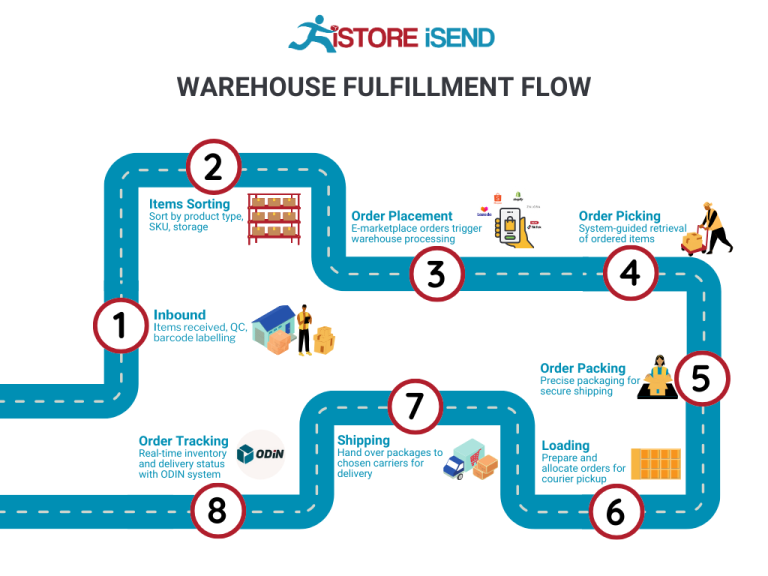
Importance: Effective packing not only safeguards products but also contributes to a positive unboxing experience for customers. Properly packed orders reduce the likelihood of returns due to damage, thereby improving overall customer satisfaction and retention.
Key Term: Packing Slip – A document that accompanies the shipment, listing the items included in the order, which helps the customer verify that they received what they ordered.
5. Shipping & Delivery
The final step in the order fulfillment process is shipping and delivery. Once orders are packed, they are labeled for shipping and handed over to carriers for delivery. Tracking numbers are generated to provide customers with real-time updates on their order status. This stage can involve choosing between different shipping methods based on cost, speed, and destination, and leveraging multiple carriers to optimize delivery times.
Importance: Timely and reliable shipping is critical for meeting customer expectations, especially in the competitive e-commerce landscape. Effective shipping strategies can lead to increased customer loyalty and positive reviews, which are essential for scaling your business.
Key Term: Tracking Number – A unique code assigned to a package that allows both the seller and the customer to monitor its shipping progress and delivery status.
By understanding and optimizing each of these five steps in the order fulfillment process, e-commerce businesses can enhance operational efficiency, improve customer satisfaction, and ultimately scale their logistics capabilities effectively.
Comparing Fulfillment Models: In-House vs. 3PL vs. Dropshipping
Fulfillment Model Comparison Table
| Model | Who Handles Inventory | Best For (Business Stage) | Key Advantage | Key Disadvantage |
|---|---|---|---|---|
| In-House Fulfillment | The Business | Start-ups to Established | Full control over inventory and brand experience | High overhead costs and resource-intensive |
| Third-Party Logistics (3PL) | 3PL Provider | Scaling and Growth | Cost-effective, scalable, and access to expertise | Less control over inventory and potential service issues |
| Dropshipping | Supplier | Start-ups and Small Businesses | Low initial investment and minimal risk | Lower profit margins and reliance on supplier reliability |
In-House Fulfillment
In-house fulfillment involves managing all aspects of the logistics process internally. Businesses that choose this model handle their own inventory storage, order processing, picking, packing, shipping, and returns management. This model is best suited for start-ups to established businesses that seek full control over their inventory and branding. The key advantage of in-house fulfillment is the complete autonomy it provides; businesses can customize packaging, branding, and customer interactions, which helps in building a strong brand identity and enhancing customer loyalty. However, the drawbacks are significant; the high overhead costs of warehousing, staffing, and technology can be a burden, especially for smaller businesses. Additionally, managing logistics can distract from core business functions, making it challenging to scale operations effectively.
Third-Party Logistics (3PL)
Third-party logistics (3PL) providers offer outsourced fulfillment services, allowing businesses to leverage their expertise, technology, and infrastructure. In this model, the 3PL handles inventory storage, order processing, picking, packing, shipping, and even returns management. This option is particularly beneficial for businesses in the scaling and growth stages, as it provides a cost-effective solution for expanding fulfillment capabilities without the need for heavy investment in infrastructure. Key advantages of 3PL include reduced operational costs, faster shipping times through optimized networks, and the ability to focus on core business functions while leaving logistics to experts. However, businesses may experience less control over their inventory and fulfillment processes, which can lead to service inconsistencies or misalignment with brand values if the chosen 3PL does not meet expectations. Establishing a strong partnership with a reliable 3PL is crucial for mitigating these risks.
Dropshipping
Dropshipping is a fulfillment model where businesses sell products they do not keep in stock. Instead, when a customer places an order, the business purchases the item from a third-party supplier who then ships it directly to the customer. This model is ideal for start-ups and small businesses that want to minimize upfront investment and financial risk associated with inventory. The primary advantage of dropshipping is the low initial investment required; businesses can operate without the need for warehousing or maintaining inventory, which reduces overhead costs significantly. However, dropshipping comes with its challenges, including lower profit margins due to reliance on suppliers for pricing and shipping. Additionally, businesses have less control over product quality, shipping times, and customer service, which can impact customer satisfaction and brand reputation. As such, selecting reliable suppliers and maintaining good communication is vital for success in the dropshipping model.
Conclusion
Choosing the right fulfillment model is essential for e-commerce businesses aiming to scale effectively. Each model—In-House Fulfillment, Third-Party Logistics (3PL), and Dropshipping—offers unique advantages and disadvantages that can significantly impact a business’s operational efficiency, customer experience, and overall profitability. Business owners must assess their current stage, resources, and long-term goals to select the fulfillment strategy that aligns best with their growth aspirations. By understanding the nuances of each model, businesses can make informed decisions that facilitate smoother logistics operations and enhance customer satisfaction.
A Deep Dive into Amazon FBA: Pros, Cons, and Who It’s For
Understanding Fulfillment by Amazon (FBA)
Fulfillment by Amazon (FBA) is a service that enables e-commerce sellers to store their products in Amazon’s vast network of fulfillment centers. When a seller enrolls in FBA, Amazon takes over the logistics of storing, packing, and shipping products on behalf of the seller. This service is designed to help sellers scale their businesses efficiently by leveraging Amazon’s infrastructure and customer trust.
How FBA Works
-
Inventory Storage: Sellers send their products to Amazon’s fulfillment centers, where they are stored until sold. Amazon’s network is strategically located to ensure fast shipping to customers.
-
Order Processing: When a customer places an order for a product listed under FBA, Amazon automatically processes the order. This includes picking the product from the warehouse, packing it, and shipping it directly to the customer.
-
Customer Service: Amazon handles all customer inquiries and returns related to FBA orders. This includes managing refunds and product returns, which can be a significant time-saver for sellers.
-
Multi-Channel Fulfillment: Sellers can also utilize FBA to fulfill orders from other sales channels, such as their own websites or other online marketplaces, using the same inventory stored at Amazon.
Pros of Fulfillment by Amazon (FBA)
-
Prime Eligibility: Products fulfilled by Amazon are eligible for Amazon Prime, which offers customers free two-day shipping. This can significantly increase sales, as Prime members tend to prefer purchasing items that qualify for their membership benefits.
-
Customer Trust: Leveraging Amazon’s reputation can enhance customer trust. Consumers often feel more secure purchasing from sellers who use FBA, knowing that Amazon guarantees a certain level of service and reliability.
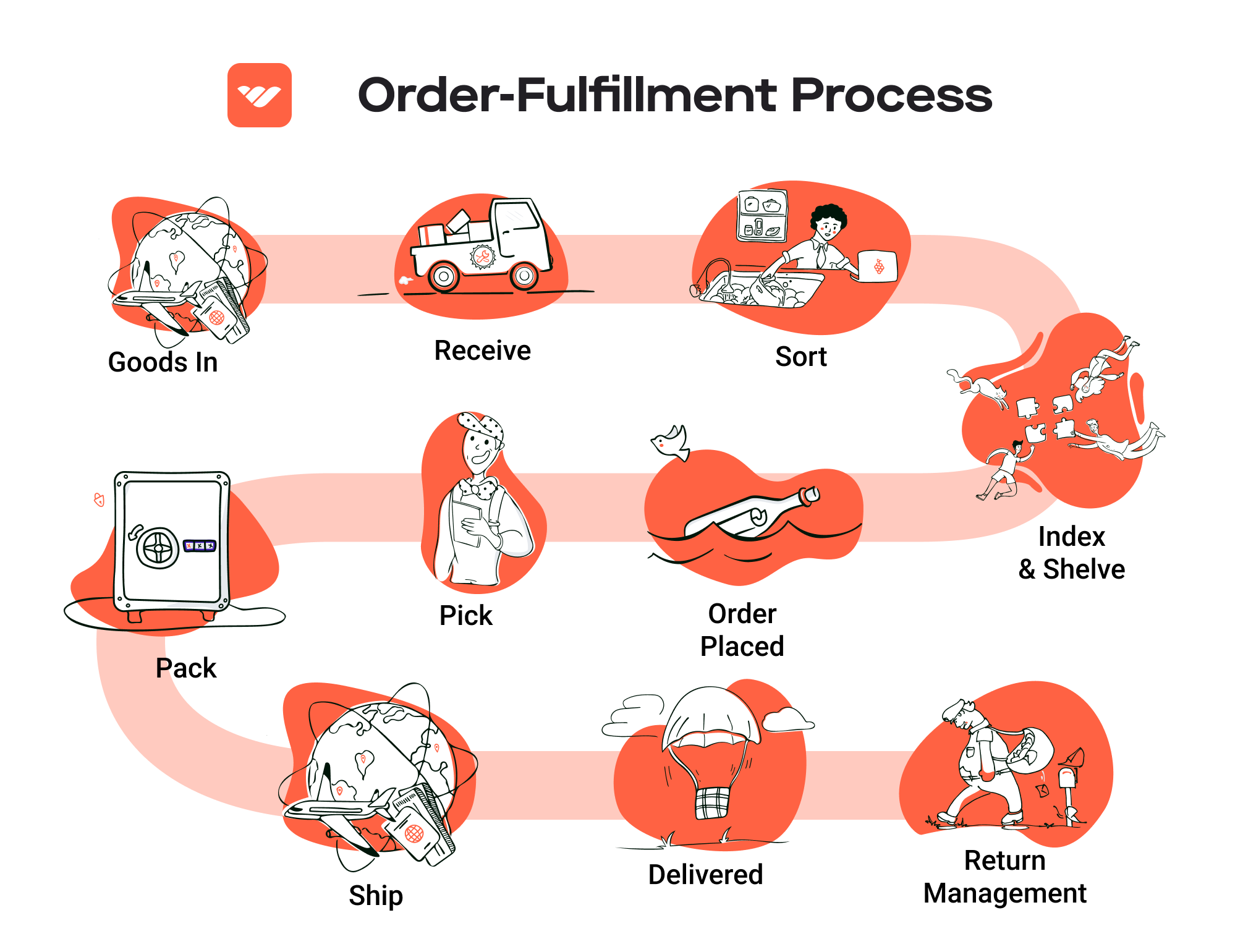
-
Multi-Channel Fulfillment: FBA allows sellers to fulfill orders from various platforms, not just Amazon. This means sellers can centralize their inventory management and streamline their operations while still reaching a broader audience.
-
Scalability: With FBA, sellers can scale their businesses without the need to invest heavily in warehousing, staffing, or logistics infrastructure. This allows them to focus more on marketing and product development.
-
Time Savings: Outsourcing fulfillment to Amazon frees up valuable time for sellers, allowing them to concentrate on other aspects of their business, such as product sourcing and customer engagement.
-
Advanced Logistics: Amazon’s sophisticated logistics system ensures efficient order processing and shipping, often resulting in faster delivery times compared to many independent fulfillment solutions.
Cons of Fulfillment by Amazon (FBA)
-
High Fees: While FBA can save time and effort, it comes at a cost. Sellers are subject to various fees, including storage fees for inventory stored in Amazon’s warehouses and fulfillment fees for each order processed. These costs can accumulate quickly, especially for sellers with lower margins.
-
Strict Inventory Rules: Amazon has stringent guidelines regarding inventory management, packaging, and labeling. Sellers must ensure their products comply with these requirements, which can be challenging and time-consuming.
-
Commingling Risks: Amazon’s FBA program pools inventory from multiple sellers, which means that products from different sellers may be stored together. This can lead to issues if a customer receives a product that doesn’t match their order, potentially affecting seller ratings and reviews.
-
Limited Control Over Branding: When using FBA, sellers have less control over the packaging and presentation of their products. Amazon’s standardized packaging may not allow for personalized branding, which can be a disadvantage for businesses that prioritize brand identity.
-
Inventory Management Complexity: Managing inventory levels can be tricky with FBA, especially when accounting for sales velocity and seasonal demand. Sellers must be vigilant to avoid stockouts or excess inventory, both of which can incur additional fees.
-
Dependency on Amazon: Relying on Amazon for fulfillment can create challenges if the company changes its policies or fees. Sellers may find themselves vulnerable to shifts in Amazon’s business model.
Who is FBA Best For?
Fulfillment by Amazon is best suited for sellers who:
-
Have a High Sales Volume: Sellers with a consistent and high volume of orders can benefit significantly from FBA, as the fulfillment fees may be outweighed by the increased sales and visibility.
-
Sell Consumer Products: Businesses that sell products that appeal to a broad consumer base, especially those eligible for Prime, will find FBA advantageous.
-
Lack Fulfillment Infrastructure: Newer sellers or those without the resources to manage their own fulfillment operations will appreciate the convenience and efficiency of FBA.
-
Seek to Expand Quickly: Sellers looking to scale their operations without heavy investments in logistics or warehousing will find FBA an effective solution.
-
Desire a Hands-Off Fulfillment Solution: For those who prefer to focus on marketing and product development rather than logistics, FBA provides a way to delegate order fulfillment.
In conclusion, while Fulfillment by Amazon offers numerous advantages, it’s crucial for sellers to weigh these against the potential downsides. Understanding the intricacies of FBA can help e-commerce businesses make informed decisions about whether this fulfillment model aligns with their growth strategies and operational capabilities.
Core Services Offered by Fulfillment Centers
Inventory Management & Warehousing
Inventory management and warehousing are foundational services provided by fulfillment centers, designed to streamline the storage and organization of products. Fulfillment centers utilize sophisticated inventory management systems that enable e-commerce businesses to track stock levels in real-time, ensuring that products are available when customers place orders. This service includes receiving inventory, categorizing products, and maintaining optimal stock levels to prevent overstocking or stockouts.
Benefits for E-commerce Businesses:
– Real-Time Visibility: Businesses gain access to live data on inventory levels, helping to make informed decisions regarding purchasing and stock replenishment.
– Cost Efficiency: By outsourcing warehousing, e-commerce businesses can significantly reduce overhead costs associated with maintaining their own storage facilities, including rent, utilities, and staffing.
– Scalability: As businesses grow, fulfillment centers can easily accommodate increased inventory without the need for significant capital investment in physical space or infrastructure.
Pick and Pack Services
Pick and pack services are crucial in the fulfillment process, where items are selected from inventory (picked) and prepared for shipment (packed). Fulfillment centers employ skilled staff and advanced technology to ensure that orders are fulfilled accurately and efficiently. The process typically involves verifying product availability, selecting the correct items, packing them securely, and labeling them for shipment.
Benefits for E-commerce Businesses:
– Speed and Accuracy: Automated systems and trained personnel enhance order accuracy and reduce the time it takes to process orders, leading to improved customer satisfaction through timely delivery.
– Custom Packaging: Fulfillment centers often provide custom packaging options that can enhance branding, allowing businesses to include promotional materials or personalized messages with shipments.
– Reduced Labor Costs: By outsourcing pick and pack operations, businesses can minimize labor costs and focus their resources on core activities such as marketing and product development.
Kitting and Assembly
Kitting and assembly services involve combining multiple products into a single package or kit before shipping. This service is particularly beneficial for businesses that sell products that are often used together or require assembly prior to delivery. Fulfillment centers can handle the entire kitting process, ensuring that items are packaged correctly and efficiently.
Benefits for E-commerce Businesses:
– Enhanced Customer Experience: By providing kitted products, businesses can offer customers a more convenient shopping experience, bundling related items together and potentially increasing the average order value.
– Streamlined Operations: Outsourcing kitting and assembly allows businesses to save time and resources, as fulfillment centers handle the complexity of assembling and packaging products.
– Flexibility: Fulfillment centers can adapt to seasonal demands or promotional events, quickly ramping up kitting operations to meet increased order volumes without requiring businesses to invest in additional resources.
Returns Management (Reverse Logistics)
Returns management, often referred to as reverse logistics, is a critical service offered by fulfillment centers that focuses on handling product returns efficiently. This process includes receiving returned items, inspecting them for damage, restocking them if they are in sellable condition, or managing their disposal if necessary. Effective returns management is vital for maintaining customer satisfaction and loyalty.
Benefits for E-commerce Businesses:
– Time Savings: Handling returns can be time-consuming and complex. Fulfillment centers take this burden off businesses, allowing them to focus on growth and customer engagement rather than processing returns.
– Improved Customer Satisfaction: A streamlined returns process enhances the overall customer experience, as customers appreciate easy and hassle-free return options. This can lead to increased repeat purchases and positive word-of-mouth.
– Data Insights: Fulfillment centers can provide valuable data on return reasons and trends, enabling businesses to identify potential issues with products and improve offerings based on customer feedback.
By leveraging the core services of fulfillment centers, e-commerce businesses can optimize their operations, reduce costs, and improve customer satisfaction—all critical factors for scaling successfully in a competitive market.
How to Choose a Fulfillment Partner: A 6-Point Checklist
Location & Warehouse Network
Importance: The geographical location of your fulfillment partner’s warehouses directly impacts shipping times and costs. A strategically located network can help you reach your customers faster, improve delivery efficiency, and reduce shipping expenses.
Questions to Ask:
– Where are your fulfillment centers located, and how do they align with our target customer demographics?
– What is your average shipping time to key regions?
– Do you have a plan for expanding your warehouse network as our business grows?
Technology & Integrations
Importance: A robust technological framework is essential for seamless operations. The right fulfillment partner should offer advanced software solutions for order management, inventory tracking, and reporting, as well as the ability to integrate with your existing e-commerce platforms.
Questions to Ask:
– What technology platforms do you use for order processing and inventory management?
– Can your system integrate with our e-commerce platform (e.g., Shopify, Amazon Seller Central)?
– Do you provide real-time tracking and reporting capabilities?
Specializations (e.g., Cold Storage, Oversized Items)
Importance: Depending on your product type, you may require specific storage conditions or handling capabilities. Understanding a fulfillment partner’s specializations can ensure your products are stored and shipped according to their unique requirements.
Questions to Ask:
– What types of products do you specialize in handling (e.g., perishable goods, oversized items)?
– Do you have specific facilities for temperature-sensitive products?
– How do you handle unique packaging or shipping requirements for specialized items?
Scalability & Capacity
Importance: As your business grows, your fulfillment needs will change. A suitable partner should have the capacity and flexibility to scale operations accordingly without compromising service quality.
Questions to Ask:
– What is your current capacity, and how do you handle seasonal demand fluctuations?
– How quickly can you scale up operations to meet increased order volumes?
– Do you have contingency plans in place for unexpected demand spikes (e.g., promotions, holiday seasons)?
Pricing and Contracts
Importance: Understanding the pricing structure and contractual obligations is crucial for maintaining profit margins. Transparency in pricing can help you avoid hidden fees that may impact your bottom line.
Questions to Ask:
– Can you provide a detailed breakdown of your pricing model (e.g., storage, picking, packing, shipping)?
– What are the terms of your contract, and are there any hidden fees we should be aware of?
– How do you handle pricing adjustments as our order volumes change?
Customer Support & Reviews
Importance: Reliable customer support is essential for resolving issues quickly and maintaining smooth operations. Additionally, checking reviews and testimonials can provide insights into the partner’s reliability and service quality.
Questions to Ask:
– What customer support channels do you offer (e.g., phone, email, live chat)?
– What are your average response times for customer inquiries or issues?
– Can you provide references or case studies from businesses similar to ours?
Conclusion
Choosing the right fulfillment partner is a pivotal decision that can significantly impact your e-commerce operations. By thoroughly assessing potential partners based on the criteria outlined in this checklist, you can make an informed choice that aligns with your business goals and customer expectations. Prioritize partners who not only meet your current needs but are also equipped to support your growth and adapt to the evolving landscape of e-commerce.
Understanding Fulfillment Pricing: A Breakdown of Common Fees
Initial Setup Fees
When engaging a fulfillment service, businesses often encounter initial setup fees. These fees cover the costs associated with onboarding, which can include account setup, software integration, and training on the fulfillment platform. Depending on the complexity of the services provided and the specific requirements of the business, these fees can range from a few hundred to several thousand dollars.
The calculation of initial setup fees typically considers the following factors:
– Complexity of Integration: If your systems require extensive customization to integrate with the fulfillment provider’s technology, expect higher fees.
– Volume of Products: More products generally mean more time and resources needed to set up the inventory in the system.
– Training Needs: If your team requires extensive training to navigate the fulfillment system, this may also contribute to higher initial costs.
Receiving Fees
Receiving fees are charged when your products are delivered to the fulfillment center. These fees cover the labor and equipment costs associated with unloading, inspecting, and entering inventory into the system. Receiving fees can vary based on the volume and type of products being processed.
Key elements influencing receiving fees include:
– Volume of Inventory: Larger shipments can result in lower per-unit costs due to economies of scale.
– Type of Products: Specialized handling, such as fragile or oversized items, may incur additional charges.
– Inspection Requirements: If your products require detailed inspection or quality checks upon arrival, this can also increase fees.
Storage Fees (per pallet/bin)
Storage fees are charged for the space your inventory occupies within the fulfillment center. These fees are typically calculated on a per-pallet or per-bin basis and can vary depending on the size of your inventory and the duration it remains stored.
Factors that affect storage fees include:
– Pallet vs. Bin Storage: Pallet storage is generally less expensive than bin storage, as pallets can maximize space efficiency.
– Duration of Storage: Longer storage periods can lead to increased costs, with some providers implementing tiered pricing models based on the length of time items are stored.
– Seasonal Demand: During peak seasons, such as holidays, storage rates may increase due to higher demand for space.
Pick & Pack Fees (per item/order)
Pick and pack fees are charged for the labor involved in picking items from storage, packing them for shipment, and preparing them for delivery. This fee can be structured in two ways: per item or per order, with the chosen model depending on the business’s order volume and product variety.
Key considerations in calculating pick and pack fees include:
– Number of Items: More items in an order will generally lead to higher pick and pack fees, especially if the fees are item-based.
– Complexity of Packing: Orders that require special packaging, such as gift wrapping or including promotional materials, may incur additional costs.
– Volume Discounts: Businesses with high order volumes may negotiate reduced fees per order or item.
Shipping Fees
Shipping fees cover the cost of transporting orders from the fulfillment center to the customer. These fees can vary based on several factors, including shipping distance, the weight of the package, and the chosen shipping method (standard, expedited, etc.).
Shipping fees are calculated based on:
– Weight and Dimensions: Heavier and larger packages typically cost more to ship.
– Shipping Method: Different carriers and service levels (e.g., ground vs. air) will have varying price points.
– Destination: Shipping costs can differ significantly based on whether the destination is local, national, or international.
Tips for Getting an Accurate Quote
-
Provide Detailed Information: When seeking quotes, be transparent about your average monthly order volume, product dimensions, and specific fulfillment needs. This information helps providers offer more accurate pricing.
-
Ask About All Fees: Inquire about all potential fees, including hidden costs like returns handling or additional packaging requirements, to avoid surprises later.
-
Consider Volume Discounts: If your business anticipates growth, discuss volume-based pricing structures that could reduce costs as your order volume increases.
-
Evaluate Multiple Providers: Compare quotes from several fulfillment centers to understand the market rates and find a provider that meets your needs without compromising service quality.
-
Review Contract Terms: Ensure you understand the terms of the contract, including any penalties for early termination or changes in order volume, which could affect your overall costs.
By understanding these common fulfillment pricing models and their calculations, e-commerce business owners can make informed decisions that optimize their logistics strategy and support scalable growth.
Frequently Asked Questions (FAQs) about Fulfillment
1. What is Amazon fulfillment?
Amazon fulfillment refers to the complete logistics process that sellers use to manage their products on Amazon. This includes inventory storage, order processing, picking, packing, shipping, and handling returns. The goal is to meet Amazon’s strict requirements and customer expectations efficiently.
2. What’s the difference between a warehouse and a fulfillment center?
A warehouse is primarily a storage facility for goods, while a fulfillment center is designed to handle the entire order processing workflow. Fulfillment centers focus on picking, packing, and shipping orders directly to customers, often incorporating advanced technology for inventory management and order tracking.
3. What is a 3PL?
A 3PL, or third-party logistics provider, is a company that offers outsourced logistics services, including warehousing, transportation, and order fulfillment. For e-commerce businesses, partnering with a 3PL can help streamline operations, reduce overhead costs, and improve delivery times without the need to manage logistics in-house.
4. How much do fulfillment services cost?
The cost of fulfillment services varies based on several factors, including order volume, storage space needed, and specific services required (like packaging or returns management). Generally, pricing models can include a per-order fee, monthly storage fees, and additional costs for special handling or expedited shipping. It’s advisable to request quotes from multiple providers to compare.
5. Can I integrate my Amazon store with a fulfillment service?
Yes, most fulfillment services offer integration with Amazon Seller Central. This allows for seamless order processing, real-time inventory updates, and efficient shipping management. Integration helps streamline operations and ensures that your orders are fulfilled according to Amazon’s standards.
6. How does Amazon FBA differ from using a 3PL?
Fulfillment by Amazon (FBA) allows sellers to store their products in Amazon’s warehouses, with Amazon handling all aspects of order fulfillment. In contrast, a 3PL provides more flexibility, including custom packaging, branding options, and support across multiple sales channels. Additionally, a 3PL may offer lower costs and personalized support compared to FBA.
7. Can a 3PL handle returns for my Amazon orders?
Yes, many 3PL providers can manage the entire returns process for your Amazon orders. This includes receiving returned items, inspecting them, and either restocking or disposing of them according to your instructions, which can significantly reduce the workload for sellers.
8. How do I choose the right fulfillment partner?
When selecting a fulfillment partner, consider factors such as their experience with Amazon, scalability options, technology integration capabilities, geographic coverage, and customer service responsiveness. It’s also beneficial to read reviews and case studies to gauge their performance and reliability.
9. What are the benefits of using a fulfillment center?
Using a fulfillment center can lead to several advantages, including reduced overhead costs, faster shipping times, improved order accuracy, and access to advanced logistics technology. These benefits can enhance customer satisfaction and allow businesses to focus on growth rather than day-to-day logistics.
10. Do fulfillment centers support international shipping?
Yes, many fulfillment centers offer international shipping capabilities. They can help businesses navigate the complexities of cross-border logistics, including customs regulations and local compliance, allowing sellers to expand their reach to global markets efficiently.
Conclusion: Is Outsourcing Fulfillment the Right Move for Your Business?
Evaluating the Benefits of Outsourcing Fulfillment
Outsourcing fulfillment can be a game-changer for e-commerce businesses looking to streamline operations and scale efficiently. By leveraging third-party logistics (3PL) providers, businesses can save significant time and resources. This allows entrepreneurs and operations managers to focus on core activities such as product development and marketing, rather than getting bogged down in the complexities of order processing, inventory management, and shipping logistics.
One of the primary benefits of utilizing a fulfillment service is scalability. As your order volume grows, a 3PL can effortlessly accommodate increased demand without the need for significant capital investment in infrastructure. This flexibility is crucial for businesses navigating seasonal spikes or unexpected surges in demand, enabling them to maintain high service levels and customer satisfaction.
Moreover, partnering with a fulfillment expert brings invaluable industry knowledge and expertise. These providers are well-versed in compliance with various shipping regulations, packaging requirements, and customer service expectations. This expertise can help businesses optimize their operations, ensuring that they meet marketplace standards and avoid costly mistakes.
However, it’s essential to choose the right fulfillment partner. Not all 3PLs are created equal, and the wrong choice can hinder your growth rather than support it. Evaluate potential partners based on their capabilities, technology, and alignment with your business goals.
To determine if outsourcing fulfillment is the right next step for your business, conduct an audit of your current shipping processes. Assess where inefficiencies lie and how a 3PL could enhance your operations. By taking this strategic approach, you can position your business for sustainable growth and customer satisfaction in an increasingly competitive landscape.
Important Disclaimer
⚠️ Important Disclaimer
The information in this guide is for educational purposes. Fulfillment services, pricing, and platform features change frequently. Always conduct your own due diligence and consult with providers directly before making business decisions.

